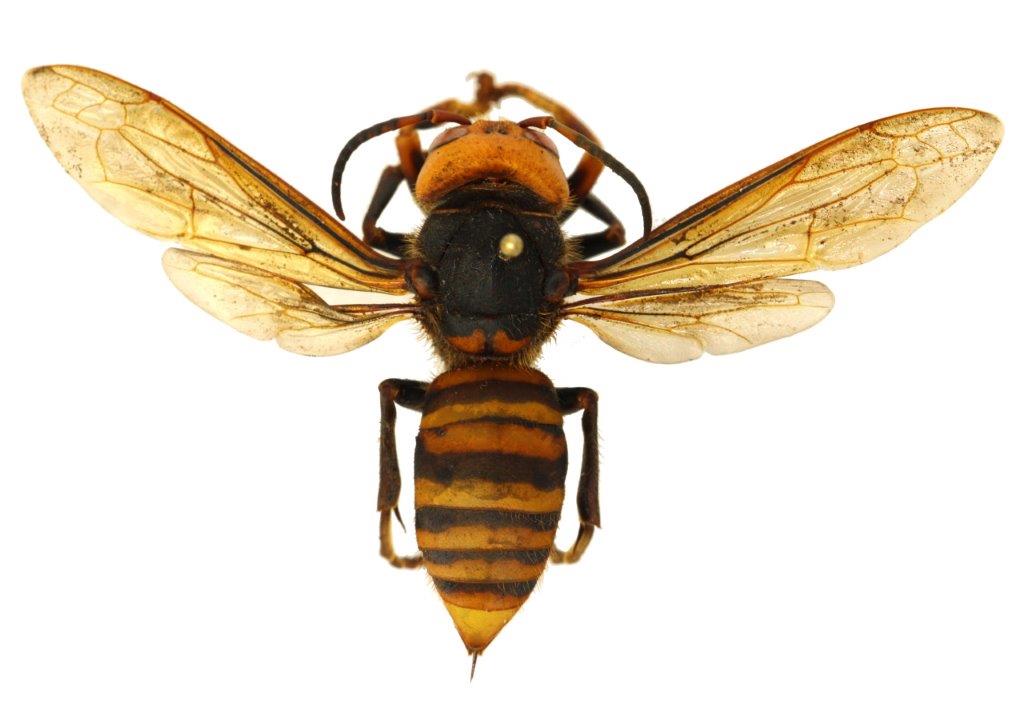Giant hornets genuinely frightening
Posted on May 05, 2020 by Mike Merchant https://citybugs.tamu.edu/author/mike-merchant/
The Asian giant hornet has recently been spotted close to the Canadian border in Washington state. Photo courtesy Washington State Department of Agriculture.
Last year’s quiet arrival of a foreign wasp known as the Asian giant hornet is no longer a secret outside of Washington state. Within the past few days, all the major TV networks have broadcast stories of the arrival of the wasp to the Pacific Northwest. Known to entomologists as Vespa mandarinia, it has been named by the press the ‘murder hornet’.
It’s hard to argue with the name ‘murder hornet’ given that this wasp causes 30-50 human deaths a year in Japan. And the threat is serious enough that the Washington State Department of Agriculture has devoted a website to the pest and assigned public engagement officer, Karla Salp, to handle public concerns. “Our hope is to eradicate it before it can get established in Washington,” she said. “Barring that, containing it is our second goal.”
Let’s face it, the thought of giant stinging wasps touches our deepest fears. If proof was needed of how scary wasps are to most people, look no further than the Hunger Games and its “tracker jacker” wasps. Even Hollywood knows the idea of being attacked by a swarm of wasps or bees is horrifying in the most primal way (and therefore sells tickets).
How bad?
Given the fact that lots of other stinging wasps and bees are already a part of the landscape in Texas, why the fuss? After all, it’s just another wasp. One of the reasons the Asian giant wasp generates so much attention is its size. At 1 1/2 inches long (queens up to 2 inches) it is reportedly the largest wasp in the world. Its sting is excruciating and, unlike the honey bee, it can sting repeatedly.
The
Asian giant hornet has a distinctive yellow-orange head and heavier
body than those of our largest native wasps. Photo courtesy Washington
State Department of Agriculture.
And while we’re talking bees, a gang of 30 Asian giant hornets can take out a hive of 30,000 honey bees in a few hours. The European honey bee–the predominant species used by beekeepers–lacks the behavioral defenses that Japanese honey bees use against this wasp. With its giant jaws capable of decapitating honey bee defenders, and a exoskeleton impervious to bee stings, the giant hornet makes a formidable foe. To make matters worse, beekeepers who encounter these wasps face 1/4-inch-long stingers that penetrate standard beekeeper garb.
Impact on Texas
The bottom-line is that the chance of Asian giant hornets invading Texas soon is slim, given that at the moment only a few wasps have been found in only one county in the far northwest corner of the U.S. Also, hornets are less likely to be transported by humans than many other exotic insects, like fire ants or emerald ash borers.As with any social insect, hornets live and survive in colonies, not as individuals. So an individual wasp that accidentally flies into a vehicle and gets transported cannot survive away from its colony. The only way to spread the wasp is by transporting an entire subterranean nest, or to transport a (much rarer) previously mated queen, capable of starting a new nest on her own.
Natural spread on the ground could certainly also occur, but it should take much longer. In China the wasps seem to favor forested areas and avoids high altitudes and open grasslands. Texas does not seem to be ideal habitat for this wasp. Nevertheless, it’s hard to feel completely safe from an insect that just successfully hopped an ocean. And according to Salp there is genetic evidence that the Asian giant hornet (against all odds) slipped into British Columbia not once, but twice in the past year.
Look-alikes

The cicada killer wasp, Sphecius speciosus, is another large wasp, approaching the length of the Asian giant wasp, common in Texas.
It’s not unusual when a scary new pest gets reported in the news for everyone to start seeing them in their backyard (it’s a natural human response to believe that if something bad is going to happen, it will happen to us personally first). But in this case, there are much better explanations for big hornets in your backyard. In Texas one of our largest stinging insects is the cicada killer wasp. Cicada killers range in size from 1 to 1 1/2 inches-long, approaching the Asian giant wasp in length. Although the bodies of cicada killers are more slender, and heads not as distinctively orange, they are still easily mistaken for the more sinister giant hornet.
Washington state officials are also responding to a worried public. “We have created a chart to show people the size differences in native bees and wasps compared to the Asian giant wasp,” said Salp. “Its common to see other wasps and mistake them for the giant wasp.”
In Texas, it is highly unlikely that the Asian giant hornet will be spotted for many years, if ever. But if you see something unusual, a good picture is usually sufficient to roughly identify a bee or wasp. Send the image to your county Extension office with a description of the city and county and date where it was taken. Also, as accurately as possible estimate the length of the insect. The better the picture and description, the more likely you are to get an answer.
And, as for now, don’t watch the Hunger Games if you want to sleep well tonight.
-------------------------------------
Thanks Mike!
Blayne
No comments:
Post a Comment